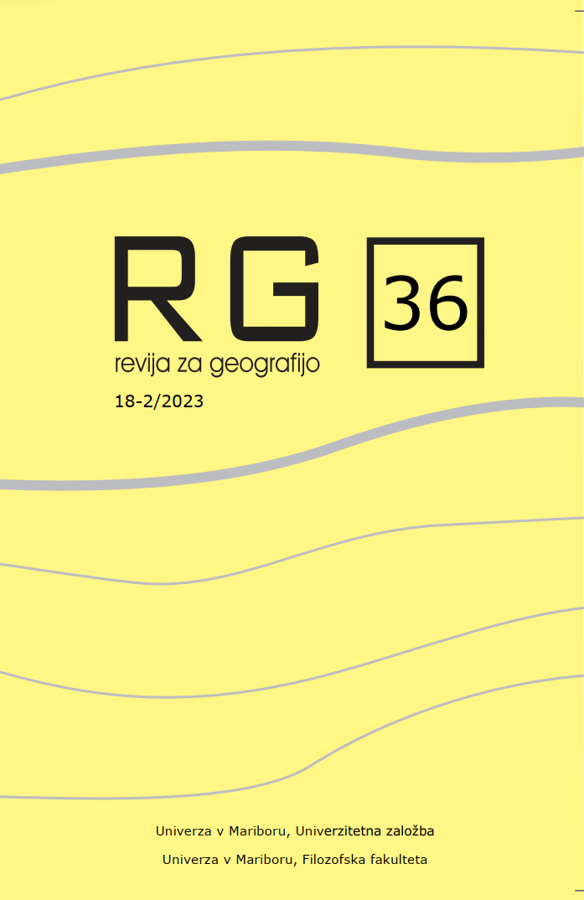Heat Waves in Sarajevo in the Period 1901-2018
DOI:
https://doi.org/10.18690/rg.18.2.3349Keywords:
Urban heat island, heat wave, universal thermal climate index, UTCI, SarajevoAbstract
The article analyzes heat waves in Sarajevo in the period 1901—2018. We presented the trends in the number of heat waves, their length, the highest air temperatures during heat waves and the cumulative highest temperatures during heat waves. We also discussed the trends of the universal thermal climate index for Sarajevo in the period 1961—2018, which show the burdensome thermal effect on humans in a more integral way. In Sarajevo we observe an increase in the number of heat waves, the number of days in heat waves and the cumulative maximum temperatures in heat waves. After 1961, the burdensome thermal effect in the summer months also increases, which also indicates a positive trend in the value of the universal thermal climate index.
Downloads
References
Anderson B.G., Bell M.L., (2009). Weather-Related mortality: How heat, cold, and heat waves affect mortality in the United States. Epidemiology, 20(2), 205-2013. https://doi.org/10.1097/ede.0b013e318190ee08
Australian Government, Bureau of Meteorology. (2023a). First heatwave for Adelaide in 2010. Retrieved March 19, 2023, from http://www.bom.gov.au/announcements/media_releases/sa/20100115_First_Heatwave_SA_Jan.shtml
Australian Government, Bureao of Meteorology (2023b).Glossary. Retrieved March 19, 2023, from http://www.bom.gov.au/lam/glossary/hpagegl.shtml
Baccini M., Biggeri A., Accetta G., Kosatsky T., et al., (2008). Heat effects on mortality in 15 European cities. Epidemiology, 19(5), 711-719. https://doi.org/10.1097/ede.0b013e318176bfcd
Basu R., Samet J.M., (2002). Relation between elevated ambient temperature and mortality: a review of epidemiological evidence. Epidemiological Review, 24(2), 190-202. https://doi.org/10.1093/epirev/mxf007
Błażejczyk, K., Jendritzky, G., Bröde, P., Fiala, D., Havenith, G., Epstein, Y., Psikuta, A., & Kampmann, B. (2013). An introduction to the universal thermal climate index (UTCI). Geographia Polonica, 86(1). http://dx.doi.org/10.7163/GPol.2013.1
Bonan, G. (2008). Ecological Climatology. Concepts and Applications. Cambridge University Press. Cambridge.
DMI. (2023). Danmark får varme- og hedebølge. Retrieved March 20, 2023, from https://web.archive.org/web/20080723170544/http://www.dmi.dk/dmi/danmark_faar_varme-_og_hedeboelge
Donia R.J., (2006) Sarajevo: biografija grada. Historijske monografije. Institut za istoriju. Sarajevo.
ECA. (2023). Daily data: Download predefined subsets (ASCII). Retrieved March 20, 2023, from https://www.ecad.eu/dailydata/predefinedseries.php
EEA, (2012). Urban adaptation to climate change in Europe, EEA Report No.2/ 2012.
EEA, (2017). Climate change, impacts and vulnerability in Europe 2016. An indicator-based report. EEA Report No. 1/2017.
European Climate Assessment & Dataset (ECA&D). (2013). Algorithm Theoretical Basis Document. Royal Netherlands Meteorological Institute KNMI.
Fezer, F. (1994). Das Klima der Städte. Justus Perthes Verlag, Gotha.
Gartland, L. (2008). Heat Island. Understanding and Mitigating Heat in Urban Areas. Earthscan. London.
Google Earth. (2023).
Hadžidervišagić D. (2011). Historijski razvoj urbanih zelenih površina u Sarajevu. Naše šume, 24-25(10), 23-31.
Hajat, S., Vardoulakis, S., Heaviside, C., et al, (2014) Climate change effects on human health: projections of temperature-related mortality for the UK during the 2020s, 2050s and 2080s. Journal of Epidemiology and Community Health; 68:641-648.
Hansen, J., Ruedy, R., Sato, M., & Lo, K. (2010). Global surface temperature change. Review of Geophysics, 48(4), RG4004. https://doi.org/10.1029/2010RG000345
Hsiang, S., Deryugina, T. (2014). Does the Environment Still Matter? Daily Temperature and Income in the United States. NBER Working Paper No. 20750.
Hsiang, S., Marshall, B., Edward, M., (2015). Climate and Conflict. Annual Review of Economics, 7(1), 577–617. https://doi.org/10.1146/annurev-economics-080614-115430
Kenney, W. L., & Munce, T. A. (2003). Invited review: aging and human temperature regulation. Journal of applied physiology (Bethesda, Md. : 1985), 95(6), 2598–2603. https://doi.org/10.1152/japplphysiol.00202.2003
Kladnik, R. (1988). Termodinamika. Tehniška založba Slovenije, Ljubljana.
Meehl, G. A., & Tebaldi, C. (2004). More intense, more frequent, and longer lasting heat waves in the 21st century. Science, 305(5686), 994-997. https://doi.org/10.1126/science.1098704
MetOffice. (2023). The Russian heatwave of summer 2010. Retrieved April 20, 2023, from https://www.metoffice.gov.uk/weather/learn-about/weather/case-studies/russian-heatwave
Monteith, J.L., Unsworth, M.H., (1990). Principles Of Environmental Physics. Edward Arnold, New York.
Oke, T.R. (1992). Boundary Layer Climates. Routledge, London.
Parsons, K., (2014). Human Thermal Environments. CRC Press. New York.
Robine, J.-M., Cheung, S. L. K., Le Roy, S., Van Oyen, H., Griffiths, C., Michel, J.-P., & Herrmann, F. R. (2008). Death toll exceeded 70,000 in Europe during the summer of 2003. Comptes Rendus Biologies, 331(2), 171-178. https://doi.org/10.1016/j.crvi.2007.12.001
Robinson, P. (2001). On the Definition of a Heat Wave. Journal of Applied Meteorology, 40(4), 762–775. https://doi.org/10.1175/1520-0450(2001)040%3C0762:OTDOAH%3E2.0.CO;2
Roetzer, T., Wittenzeller, M., Haeckel, H., & et al. (2000). Phenology in central Europe – Differences and trends of spring phenophases in urban and rural areas. International Journal of Biometeorology, 44, 60–66. https://doi.org/10.1007/s004840000062
Topografska karta, 1:25.000, List Sarajevo. GIJNA. Beograd.
UN DESA. (2018a). 2018 Revision of World Urbanization Prospects [Podatkovna baza]. https://www.un.org/development/desa/en/news/population/2018-revision-of-world-urbanization-prospects.html
UN DESA. (2018b). World Urbanization Prospects 2018. Population of Urban and Rural Areas at Mid-Year (thousands) and Percentage Urban, 2018. [Podatkovna baza]. https://population.un.org/wup/Download/
United Nation, 2013. Department of Economic and Social Affairs, Population Devision. World Population Ageing 2013 ST/ESA/SER.A/348.
USGS. (2023). Earth Explorer. (10.5.2023). https://earthexplorer.usgs.gov/
WMO, (2015). Guidelines on the defintion and monitoring of extreme weather and climate events. Draft version. First review by TT.
Zalar, M., Pogačar, T., Črepinšek , Z., Kajfež-Bogataj, L. (2017). Vročinski valovi kot naravna nesreča v mestih, Naravne nesreče 4. SAZU. Ljubljana.
Žiberna, I., (1996). Mestna klima Maribora. Doktorska disertacija. Oddelek za geografijo. Filozofska fakulteta. Univerza v Ljubljani. Ljubljana.
Žiberna, I., (2006). Trendi temperatur zraka v Mariboru kot posledica razvoja mestnega toplotnega otoka. Journal for Geography/Revija za geografijo 1(1), 81-98.
Žiberna, I., (2017). Spreminjanje podnebja na lokalnem nivoju: mestna klima Maribora. Predavanje na posvetu Spreminjamo gradbeno kulturo. Inženirska zbornica Slovenije, Regijska pisarna Maribor. 25.9.2017.
Downloads
Published
Issue
Section
License
Copyright (c) 2023 Igor Žiberna, Nusret Dešković, Ranko Mirić

This work is licensed under a Creative Commons Attribution 4.0 International License.
